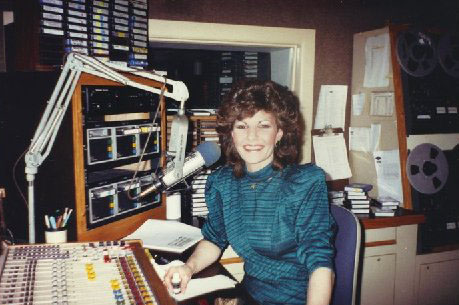![]()
Category: Flashbacks
LOST 45
![]()
WKNR: ON THE RADIO WITH JIM TATE AND MAC OWENS * AUGUST 21, 1970
 From the MCRFB Aircheck Library:
From the MCRFB Aircheck Library:
Jim Tate and Mac Owens on WKNR-AM 13 August 21, 1970
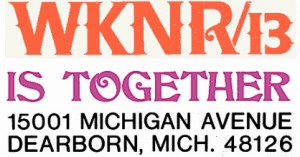 Today is the 21st day of August and MCRFB will be showcasing two complete airchecks (nearly 2 full hours) from WKNR with Jim Tate and Mac Owens. These WKNR airchecks was recorded 42-years ago in 1970, it was a Friday, and it was August 21.
Today is the 21st day of August and MCRFB will be showcasing two complete airchecks (nearly 2 full hours) from WKNR with Jim Tate and Mac Owens. These WKNR airchecks was recorded 42-years ago in 1970, it was a Friday, and it was August 21.
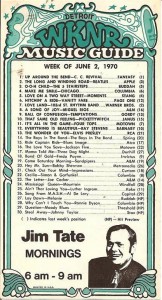
These two Keener airchecks was adapted from a saved 1970 WKNR logger tape recorded ultra-slow 15/16 ips, as Jim Tate began the day just after signing-in after 6 AM. WKNR newsman Vincent Smith breaks in with the morning’s newscast at 15 past the hour with a report that a Delta Airlines jet hijacked to Cuba the previous day landed safely at Miami International Airport. The hijacker purportedly to have said to have a bomb. Some of the songs you’ll hear in this aircheck are from CCR, Sandy Posey and 100 Proof (Aged In Soul) along with Eric Burdon and War, two heavy hitters from the WKNR music guide for the week of August 17. The No. 1 song on WKNR? It was “Don’t Play That Song,” by Aretha Franklin. Also, these 1970 airchecks are loaded with memorable spots for the day, Gene Merollis Chevrolet, Canada Dry to name a few, and there’s even a spot for an adults-only flick entitled, “Tuck Me In,” at the time showing at the Trans-Lux in “vivid color” and was rated X! And for 1970, in these Keener airchecks you’ll hear what sounds like the PAMS series 39A jingle package. Here’s the rest of the WKNR deejay caravan for 1970: Dan Henderson, Chris Ryan, Bill Garcia, Gary Granger, Ron Sherwood, Bob Green, Scott Regen and Pat St. John. It’s 1970 all over again and Jim Tate is doing what he did best on Keener 13!
From the MCRFB Aircheck Library, featuring:
WKNR-AM Jim Tate AUGUST 21, 1970 Keener 13 (click name for audio)
WKNR-AM Mack Owens AUGUST 21, 1970 (click name for audio)
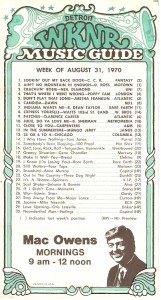
The second aircheck highlights an hour of Mac Owens signing in on his show right after Jim Tate at the 9 A.M. hour. One of the WKNR contest production promos at the time was the 1970 WKNR ‘Words’ Contest. Entrants submit lyrics for possible songs to be published and then recorded by Motown artists. Grand prize for the selected winning entry will be $1,000. You’ll hear a spot for Elias Brothers, announcing the newly-opened “Big Boy” restaurant at the Southland Shopping Center in Taylor. Remember “funny car” races at the drags? The big drag event was on Sunday for the Funny Car Spectaculars at the Motor City Dragways at I-94 and 26 Mile Rd. You’ll also hear spots with Johnny Cash for Metro Detroit Chrysler-Plymouth Dealers, Arrid Extra Dry, Pickway Shoe Mart and an offer for 2 FREE Libby 16 oz. glasses with a 10 gallon fill-up at all participating Austin-Gulf gas stations in the Detroit area. WKNR’s newsman Dick Buller reports the day’s news events as we learned 4 homicides were recorded during the night in Detroit. Songs from the WKNR Music Guide for the week of August 17 in this aircheck includes Mongo Jerry, Gene Chandler, along with the Beatles, and there was also a “classic oldie” played by Archie Bell & The Drells from 1968. On the music guide listed for the week were hits by the Carpenters, the Poppy Family, the Motown Spinners, Clarence Carter and Bread. But the most requested song for the morning according to Mac Owens was “Spill The Wine” by Eric Burdon and War, No. 10 on the WKNR Top 13. Relive Keener radio with Jim Tate and Mac Owens (And oh! What a voice!) as it happened on WKNR 42-years ago for this day in 1970 — August 21.
![]()
JIM NABORS – SHAZAM! – 1965
The Best Of Novelty Songs
![]()
THE ’65 “WHIPPED CREAM” LP COVER MODEL FOUND!
Herb Alpert ‘Whipped Cream’ Lady Now 76, Living In Longview and Looking Back
Erik Lacitis | Seattle Times staff reporter; August 15, 2012
The lady who was the model on the memorable LP cover of the 1965 A&M Herb Alpert and the Tijuana Brass’ “Whipped Cream And Other Delights” is now 76 and living in Longview. Dolores Erikson wants to tell all you teen-dreamers, “Enjoy the memories.”
SEATTLE — Guys, the girl of your teen dreams now is 76.
Her name is Dolores Erikson and she has been living in Longview for around 35 years, after a career that included being an Eileen Ford model in New York.
She appeared at a Seattle record store Wednesday and wants to tell you teen dreamers, “Enjoy the memories.”
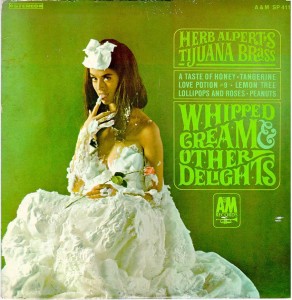
You don’t know her by name — maybe as “The Whipped Cream Lady” — but certainly by the album cover on which she is featured: the 1965 Herb Alpert & the Tijuana Brass’ “Whipped Cream And Other Delights.”
There she sits, seemingly naked but covered in what is suppose to be whipping cream looking at YOU.
Whenever a list of the most memorable album covers is put together, that album is right at the top.
How did a New Yorker magazine article explain the impact of that photo?
Oh yes, it: “fogged the minds of many young men, as they gazed at the… personalized come-hitherhood to the woman starring back… the inner portion of a bare breast protrudes from the foamed cream. She is licking cream from the index finger from her right hand… in the virtually pornless atmosphere of the suburban mid-sixties it was… the pinnacle of allure.”
The record spent 141 weeks on the Billboard’s Top 40 albums chart.
In later years, at concerts, Alpert would tell audiences, “Sorry, but I can’t play the album cover for you.”
Erikson drove up here to celebrate the 40th anniversary of Golden Oldies, the used-record store in Wallingford. A steady stream of fans stopped by, surprisingly, even women.
Toni Weschler, 56, got signed copies for her brothers. She remembers growing up in New York and playing the album.
She remembers how her brothers couldn’t take their eyes off the LP. “They starred at it constantly. It was very risque. They hadn’t seen this much breast in their life.”
For Erikson, this photo shoot was one of many in her career.
She is a 1954 Cleveland High School graduate, and her modeling began when she was 14 and won a contest at the venerable Frederick and Nelson department store in downtown Seattle.
Her modeling career blossomed, and she ended up a staff model for Macy’s in San Francisco, in the days when department stores could afford such things.
Erikson spent time in Los Angeles, signed to contracts with Paramount and then Warner Bros., but her movie and TV career mostly consisted of bit parts.
At age 24, she went to New York City and ended up being signed by Eileen Ford. She was in ads for Max Factor and was in all the women’s magazines. Erikson is 5 feet 7, with dark brown hair and green eyes, and still weighs about the same as in her modeling days, which is around 119 pounds.
But she’s cognizant of time having gone by. “Please don’t do any close-ups,” she tells a photographer.
In 1965, she got a call to fly to Los Angeles to do a photo shoot for A&M Records, a new label started by Herb Alpert and Jerry Moss. The photographer was Peter Whorf, with whom she had done other covers. Payment would be around $1,500 ($11,000 in today’s dollars), plus expenses. The shooting began mid-morning and lasted through the afternoon. Erikson put on a bikini, but with the straps down.
She was 29 and three months pregnant. “But I wasn’t showing,” she said.
Erikson sat on a stool and from the waist down, Whorf placed on her a white Christmas tree blanket.
Then shaving cream was sprayed on Erikson. Under the bright lights, whipping cream would melt, although it was real whipping on top of her head.
The shoot kept going, Erikson remembers, and she didn’t notice that the shaving cream kept slipping down. Moths later, Whorf mailed her two outtakes.
“He sent them to me. And it did shock me. I screamed,” says Erikson. “I was a Christian girl.”
Erikson has kept a copy of one of the outtakes, and it is a bit more revealing, but not by that much. But she worried that her then-husband, a New York shoe-manufacturer, and “conservative,” would become upset. She hid the two photographs behind the refrigerator at a girlfriend’s home. Later, she’d tear up the photo she deemed most revealing.
In the mid-70s, raising a young son, Erikson moved to Longview to be near her sister, and for years, ran an art studio.
Actually, it was by happenstance that back in 2000, while visiting there, that recognition began for Erikson’s role on that memorable album cover. She had stopped by Golden Oldies to buy some used copies of “Whipped Cream.” She didn’t have any copies herself and wanted to sign some for friends. Before that, the album’s importance in pop culture hasn’t registered with her.
But when Dave Silverstone, owner of Golden Oldies, found out he was actually dealing with the actual Whipped Cream lady, he thought, “it was like finding a jewel that’s been buried in the desert for over 40 years. Everybody knows about the album cover but nobody knows about her.”
By 2012 standards, that album cover is demure. Yet it endures. Teen dreams. “I looked at it as being an ice cream sundae,” Erikson says.
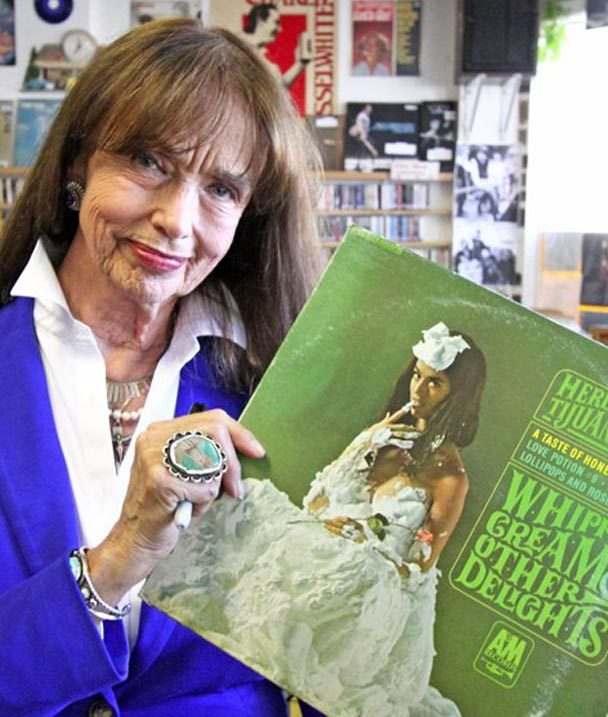
(This article originally published August 15, 2012 in The Seattle Times).
![]()
COUNTRY MUSIC MAKING STRIDE, CKLW ON TOP . . . SEPTEMBER 18, 1971
 From the MCRFB NEWS archive: 1971
From the MCRFB NEWS archive: 1971
J. P. McCARTHY NO. 1 IN MORNINGS; WDEE NO. 3 IN DETROIT: PULSE REPORT APRIL/JUNE 1971
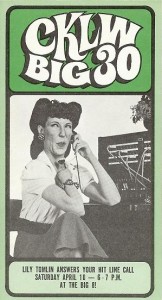 DETROIT — Country music seems to be doing well in Detroit where WDEE is third in the market 6 A.M. through midnight in the April/June Pulse. CKLW and the Paul Drew pack is No. 1 with 19, WJR comes in with a 17 and nobody touches J. P. McCarthy in the mornings: this guy has a 21 from 6-10. Across the board, WDEE, programmed by John Mazur, has a 7, 8, 6, and 3 (through hours 6-10 A.M.) Breaking the other stations down CKLW has 17, 20, 21 and 14. WABX-FM has 2, 3, 4, 6. WKNR has 3, 3, 6, 5. WRIF-FM has 0, 1, 2, 3. WCHB was pulsed with 4, 4, 5, 10. END
DETROIT — Country music seems to be doing well in Detroit where WDEE is third in the market 6 A.M. through midnight in the April/June Pulse. CKLW and the Paul Drew pack is No. 1 with 19, WJR comes in with a 17 and nobody touches J. P. McCarthy in the mornings: this guy has a 21 from 6-10. Across the board, WDEE, programmed by John Mazur, has a 7, 8, 6, and 3 (through hours 6-10 A.M.) Breaking the other stations down CKLW has 17, 20, 21 and 14. WABX-FM has 2, 3, 4, 6. WKNR has 3, 3, 6, 5. WRIF-FM has 0, 1, 2, 3. WCHB was pulsed with 4, 4, 5, 10. END
___
(Information and news source: Billboard; September 18, 1971)
![]()
MAC DAVIS – BABY, DON’T GET HOOKED ON ME
http://www.youtube.com/watch?v=636kebz3pms
THE YEAR WAS 1972
![]()
COUNTRY 1130 * WCXI * CHRIS MOSS * 1991
DETROIT COUNTRY WARS: WDEE VS WEXL . . . FEBRUARY 28, 1970
 From the MCRFB NEWS archive: 1970
From the MCRFB NEWS archive: 1970
WDEE: CAN THE DETROIT NEWCOMER BEAT WEXL TRADITION?
DETROIT — What happens when two stations of comparable signals compete in a major market and both airing respective country music formats? The answer may soon develop here as WDEE marches into a fray with WEXL, which has been a country music station since around 1962.
Slowly, but surely, in many markets good facilities are coming along in new country music formats and busting the hold of small-wattage or daytime only stations. Only in a few markets have daytime stations or small wattage stations been able to hold their own against the bigger newcomers. . . and largely only because of the growing role of FM, which these stations use to extend their broadcast day.
 But here in Detroit, two 24-hour AM stations are now waging war against each other. On one side, the most traditional station — WEXL — which believes it has established a strong listening habit in Detroit. On the other, WDEE (the former WJBK, a top 40 station before having made the switch), is perhaps a little more expansive in its approach and willing to play popular, though country-oriented, record hits in its format.
But here in Detroit, two 24-hour AM stations are now waging war against each other. On one side, the most traditional station — WEXL — which believes it has established a strong listening habit in Detroit. On the other, WDEE (the former WJBK, a top 40 station before having made the switch), is perhaps a little more expansive in its approach and willing to play popular, though country-oriented, record hits in its format.
WDEE has the advantage, if you talk to Chuck Renwick, regional radio manager who is responsible for markets such as Toledo, Cleveland, and Detroit in the Storer Broadcasting chain. “WDEE has a far superior signal,” Renwick said.
But WEXL, said program director Bill Mann, “has a fairly good signal in comparison to WDEE in spite of their 50,000 watts. Too, we got the image in the market. As far back as 1933, this station has a ‘Sagebrush Melodies’ program featuring country music.”
Go Further
WDEE claims that WEXL has commercial religion on Sunday, which doesn’t help their country image one bit. “In addition,” said Renwick, “WDEE will be aggressive in it’s promotion — running television spots and newspaper advertising. We’ll also be sponsoring our own concerts. We’ll swamp them out in promotions and with the quality of our personalities. But, in order to be successful, we feel that WDEE has to go further than that. It’s more than just beating another country music station. We don’t think our audience on WDEE will become Top 40 or middle-of-the-road as well as the potential country music fans in Detroit. But WDEE will not be zeroing in on strictly a country music audience. I’m not sure that the country music audience, as such, exists anymore, especially in a market of this size,” he said, pointing out that listeners in general were more sophisticated today. “And there are a lot of No. 1 country music stations who’ve certainly gone beyond the normal boundaries of country music fans for their audience. . . in a sense, creating additional country music fans.”

To counter WDEE in the market, WEXL is not doing anything different, said Mann. “We’re going along pretty much the same as always. That’s one of the problems WDEE has had over the years. . . . they’ve never stayed long with anything. The past six months, under the call letters of WJBK, they were a top 40 rock station. For the eight or nine months before that they were playing good music. One thing I can’t understand is why they don’t stay with any particular format long. But I don’t think that their going country music is good for country music business. It might wake up agencies to the fact that country music is important, considering that two stations are fighting for the audience.”
Adjustments
WEXL, however, has made some adjustments in its programming. Mann said that the format has been tightened up some. And the psychology of having competition has been good for the WEXL personalities. “So, we’re probably sounding better than before.” WEXL has about 50 records charted, but plays 65, plus album cuts and oldies. The station also checks out single sales, but only to an extent. “The biggest problems about singles sales in the area is that only certain stores will carry them. And even those that carry country music don’t have all of the records.”

WDEE will feature a “pretty broad-playlist,” said Renwick. “We’ll probably publish a playlist of the top 40 country records. Already, we are presenting them on the air. But we’re working off a playlist that includes up to 100 records.” One of the things WDEE is doing in order to build up a rapport quicker with Detroit listeners is that each deejay goes on the phone for a half-hour after doing his show. During this half-hour, he takes requests and chats with listeners. He is free to insert these requests into his program the next day. Besides the singles, WDEE airs between 40-60 current and recent album cuts. The major 40 records, of course, gets most-frequently play.
WDEE has just installed a package of jingles created at Spot Productions in Dallas. Production of the sound of the station is something between an easy listening and a contemporary approach, said Renwick. The deejays have now began to pull their own records, although for the first five or six weeks the station was on the air with its country music format, all of the records were slated for them. Renwick also said all the deejays had done a “lot of homework” about country music. Now they do their own shows within certain guidelines.

These guidelines include pacing in terms of tempo and a mixture between modern sounds like those of a Glen Campbell and traditional country sounds like those of a Stonewall Jackson or Faron Young. “WDEE plays the traditional things that occur in today’s hit lists. . . though the trend is towards the modern sounds,” Renwick went on to say. To put a balanced sound hour at WDEE, the deejay would play to or three of the modern-sounding records, then a Wanda Jackson: then two or three more of the modern-sounding record and a Faron Young. Album cuts are used to pick up the pace. . . to bring up the tempo. Then there are guidelines to put a separation between records that have the same kind of stories. For example, to keep a song about Carolina from being back-to-back with a song about Oklahoma. “It’s what we call a ‘thinking jocks’ format,” said Renwick. “And so far we’re getting a pretty good response on the telephone. Those half-hours that the deejay spends on the phones after his show gives us a pulse of who’s switching from other stations to us and how many of them are hardcore country music fans.”

On February 11, the station sponsored an agency party for all local time buyers, advertisers and the press. Leroy Van Dyke and his band performed. Other country artists on hand to spread the word abut country music included Jeannie C. Riley, Lynda K. Lance, Nat Stuckey, Tom T. Hall and Hank Williams, Jr.
WEXL will probably not go so “modern” as WDEE. In fact, WEXL program director Bill Mann believes that Ernest Tubb and Kitty Wells are virtually important to its programming. “I think you have to play them or you’d lose your country identity,” said Mann. Jimmy Martin won’t get exposed that much, nor the harder bluegrass sounds of the Osborne Brothers and Flatts and Scruggs. “But we do play their softer sounds. The truth is that there’s just not that much bluegrass being put out today.”
The overall sounds of WEXL seems to be good, Mann said, “from what people tell us. Of course, listeners around Detroit have never had anything with which to compare us. The competition might pick up some listeners, but I think we’ll keep the vast majority of them. And I don’t think they’ll pick up listeners from other formats because the other stations in Detroit– the Top 40 and the easy-listening stations — are playing Glen Campbell and Eddie Arnold.”
WDEE-FM also plays country music — the stereo country music package distributed by International Good Music out of Bellingham, Washington. This package is aired 6:00 A.M. through 5:00 P.M., at which point the FM station simulcast with the AM. WDEE-FM signs off at midnight at the present. END
___
(Information and news source: Billboard; February 28, 1970)


A MCRFB Note: In 2009, Detroit country radio legend Deano Day passed away. For more on this story, see Mike Austerman’s michiguide.com. Also, former-Detroit country great Tom Dean can still be heard on the world-wide web today, here.
![]()





